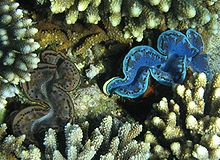- Maxima clam
-
Maxima clam 
Conservation status Scientific classification Kingdom: Animalia Phylum: Mollusca Class: Bivalvia Order: Veneroida Family: Tridacnidae Genus: Tridacna Species: T. maxima Binomial name Tridacna maxima
Röding, 1798The maxima clam (Tridacna maxima), also known as the small giant clam, is a species of bivalve found throughout the Indo-Pacific. They are much sought after in the aquarium trade, as their often striking coloration mimics that of the true giant clam, however the maximas maintain a manageable size, with the shells of large specimen typically not exceeding 20 centimetres (7.9 in) in length.
Contents
Description
The small giant clam is less than a third of the size of the true giant clam (Tridacna gigas). As an adult, it has a large shell that adheres to a rock by its byssus, a tuft of long, tough filaments that protrude from a hole next to the hinge of the shell. When open, the bright blue, green or brown mantle is exposed and obscures the edges of the shell which have prominent distinctive furrows. The small giant clam is a bivalve mollusc, referring to the two valves on the mantle. These siphon water through the body in order to extract oxygen from the water using the gills and to feed on algae.[1] The attractive colours of the small giant clam are the result of pigment cells, which have a crystalline structure inside. These are thought to protect the clam from the effects of intense sunlight, or bundle light to enhance photosynthesis, the energy-producing process carried out by the tiny algae living within.[1]
Distribution and habitat
The small giant clam has the widest range of all giant clam species. It is found in the oceans surrounding east Africa, India, China, Australia, Southeast Asia and the islands of the Pacific.[2]
Found living on the surface of reefs or sand, or partly embedded in coral,[3] the small giant clam occupies well-lit areas, due to its symbiotic relationship with photosynthetic algae, which require sunlight for energy production.[1]
Biology
A sessile mollusc, the small giant clam attaches itself to rocks or dead coral and siphons water through its body, filtering it for phytoplankton, as well as extracting oxygen with its gills. However, it does not need to filter-feed as much as other clams since it obtains most of the nutrients it requires from tiny photosynthetic algae known as zooxanthellae.[1]
Beginning life as a tiny fertilised egg, the small giant clam hatches within 12 hours, becoming a free-swimming larva. This larva then develops into another, more developed, larva which is capable of filter-feeding. At the third larval stage, a foot develops, allowing the larva to alternately swim and rest on the substrate. After eight to ten days, the larva metamorphoses into a juvenile clam, at which point it can acquire zooxanthellae and function symbiotically.[1] The juvenile matures into a male clam after two or three years, becoming a hermaphrodite when larger (at around 15 centimetres in length). Reproduction is stimulated by the lunar cycle, the time of day, and the presence of other eggs and sperm in the water. Hermaphroditic clams release their sperm first followed by the eggs later, thereby avoiding self-fertilisation.[1]
References
This article incorporates text from the ARKive fact-file "Maxima clam" under the Creative Commons Attribution-ShareAlike 3.0 Unported License and the GFDL.
- Wells, S. (1996). Tridacna maxima. 2006. IUCN Red List of Threatened Species. IUCN 2006. www.iucnredlist.org. Retrieved on 16 Jan 2007.
External links
Maxima clam media at ARKive
Categories:- IUCN Red List conservation dependent species
- Tridacna
- Fauna of Western Australia
Wikimedia Foundation. 2010.


